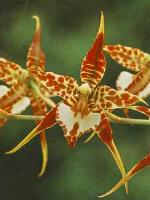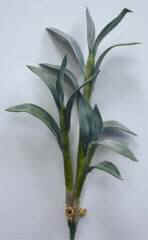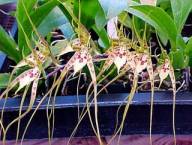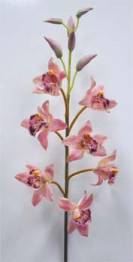|
Orchids
(By Mary Efanti)
 Growing
Orchids At Home Growing
Orchids At Home
Orchids
are impressive exotic plants. Learning
how to take care of them is a temptation as well as learning to distinguish
between basic species. Whoever
spends some time growing orchids will definitely continue to do so along with
other houseplants already at home. So,
letís learn how to take care of them.
Care
Orchids are not the
super-sensitive, hard to grow
plants most of us believe they are. After
all they are probably the largest group of plants on earth, contrary to our
belief that they are rare plants imported from exotic parts of the world.
They can do
well, as most of the other houseplants, as
long as we provide for their basic needs. Orchids
are not greenhouse-only plants; they do have some specific requirements and are
not plants to withstand neglect but everyone who can keep any houseplant alive,
definitely has what it takes to grow orchids.
Some species are easier to grow than others and if you lack the
experience they are more suitable choices in your first efforts to grow orchids.
We will provide general instructions for the care of
orchids while as the article goes along, we will concentrate on specific species
and go through any particular requirements. We will also indicate the species suitable for novice growers.
The primary parameter to keep in mind is that you
should not try to create a tropical forest environment, as the hybrids you will
buy are much more hardy than the plants in the natural habitat.
Also keep in mind that orchids live long, very long, they may even
outlive their owners.
The plants themselves will help you out since orchids will very soon demonstrate
if they like the conditions they live in. Like the eyes are the mirror or peopleís hearts, the leaves
of orchids are the mirror of their health.
So, if you inspect them regularly and carefully, you will be able to
change conditions and solve any problem very soon. Of course, there is this mystery that remains unsolved.
Some people grow exactly the same plants you grow, in the most
unbelievable spots, with absolutely minimum care and their plants do great while
you spend hours taking care of the same plants, using the best fertilizer and
soil available and your plants hardly survive . . . it has happened to every one
of us, donít give up. Just give
it a try and see for yourselves how much orchids or any other new plant likes
you.
Potting
Choose small pretty
containers, clay pots are more suitable, or transparent glass containers with drainage
wholes. Clay pots are preferable since the aeration of roots is better and the
soil dries out faster.
Orchids
do not grow in soil but in pebbles, stones, peat moss, wood or cork chips.
The potting mix should allow the roots to breathe easily and grow without
extra effort. You can buy such
material in any organized nursery or garden center, either packed mix for
orchids, or different materials with which you can create your own mixture.
Keep in mind that small particles stay wet longer while larger particles
dry out faster. To be on the safe
side, go for the larger particles if you have a choice.
You should repot every 2-3 years and only if the plants
outgrow the pot. During
repotting you can propagate the plant through division but use
extra care if you decide to do that.
 Lighting Lighting
Most orchids need
bright, filtered light, preferably
facing east or south. Like all
blooming plants, they need plenty of light to produce flowers but they need some
(even a few) hours in the dark to enhance the overall growth and health of the
plants. Do not place pots in spots
where there is light around the clock, including artificial light, because your
plant will not bloom and you may even risk losing the plant.
Inspect your orchidís leaves if you have any doubt on
whether the light they get is adequate. The
color of a healthy leaf is light green, similar to the color of the lawn.
If you notice spots like freckles or if the tone goes a little darker,
you plant is receiving the maximum amount of light it can handle.
This is the ideal quantity of light to ensure rich blooming.
If the leaves fade and start to turn
yellow, your plant
needs less light. If you notice dry
brown spots on leaves it means your plant has gotten sunburnt and you should
move it to a shaded spot. In case
the leaves turn dark green, your plant needs more light in order to grow.
In this case, the plant will survive but will not bloom.
Temperature
Ideal temperatures for most species are between 15-27įC
during the day and 11-15įC at night. The
day-night difference is the reason that enhances the production of flower buds.
Do not expose orchids to extreme temperatures, either low or high, and do
not place them in contact with windows. You
may control the indoor temperature but touching the glass will feel like being
outdoors.
Humidity
Orchids need plenty of
humidity. Place them on a pebble tray but make sure they do not stand in water and
mist them everyday early in the morning. Humidity
is useful to the plant and limits the risk of your plant getting spider mites.
You should make sure that the air circulation is good so that leaves do
not stay wet as they will rot if they do. In
order not to worry too much about humidity, keep in mind that what proves to be
adequate humidity to most houseplants is usually enough for your orchids as well.
Watering
Once a week is adequate to most
varieties. Certain species need watering more
often, especially during the blooming period.
In all varieties let the
soil go dry to the touch before watering. Rainwater
is ideal for watering, although in big polluted cities one may have plenty of
arguments against the use of such water. It
would be useful though to let tap water stand for a while before watering.
The best way to water orchids is to sink the pot in a bucket of lukewarm
water and let it stay there for a few minutes to get as much water as it needs.
Take the pot out of the water and let the excess water drain before you
take the plant back to its place.
Never let orchids stand in
water, always empty the
trays because root rot can occur really fast, root rot being the most effective
way to murder your orchid. You
should rather let your orchid thirsty than drown and never splash flowers while
watering as this can limit their life span.
Fertilization
 Always use liquid fertilizer for flowering
plants, to a
quantity that is ¼ to Ĺ of the dosage recommended and apply as usual.
The plant will indicate how often to fertilize, once a month is usually
adequate, you should fertilize less often during the winter.
When you dilute the fertilizer keep in mind the conditions your plant
lives in, plants growing in low light conditions need less fertilizer. Once every 4-6
months, place the pot inside your bathtub and water it
thoroughly so that any salt and fertilizer residues are washed away from the
soil. Always use liquid fertilizer for flowering
plants, to a
quantity that is ¼ to Ĺ of the dosage recommended and apply as usual.
The plant will indicate how often to fertilize, once a month is usually
adequate, you should fertilize less often during the winter.
When you dilute the fertilizer keep in mind the conditions your plant
lives in, plants growing in low light conditions need less fertilizer. Once every 4-6
months, place the pot inside your bathtub and water it
thoroughly so that any salt and fertilizer residues are washed away from the
soil.
In the garden and balcony
Some varieties can be cultivated
outdoors, actually
these varieties are among the most impressive and exotic. A basic requirement is that your area does not get any snow or freezing
because your orchids will die. Plants
in pots can be taken inside during the winter and then back out in spring but
plants in the garden do not have this opportunity. So, choose to plant them in spots that are protected from the scorching
afternoon sun, strong winds, and heavy rain.
The same basic instructions apply to plants grown
outdoors, although in the garden you have to depend on what nature gives you
since you can not control the weather. In
order to succeed it is necessary to choose varieties to match the conditions in
your garden.
Blooming
Orchids, the most popular
varieties, bloom in winter
and spring but you can always get orchids in bloom any time of the year.
Some varieties bloom once a year, others more often and some other
varieties throughout the year.
The fragrance of some flowers is so strong it can flood the whole neighborhood
while others have no fragrance at all. Usually,
the most impressive flowers are those that have no fragrance, since they depend
on their shapes and colors to attract insects for pollination.
Flowers, depending on the variety and the conditions, can last from 1 to 4 weeks,
with the exception of Phalaenopsis whose flowers last from 1 to 3 months.
Insects and Disease
Orchids are in general not prone to disease and
insects. The main reason is that orchids belong to entirely different parts of the
world so they are alien to the usual insects of our climate. We also cultivate them indoors so they are more protected than outdoor
plants.
This does not mean that orchids are
disease-proof. Scale can be a problem to orchids as well since they are very common to
other popular houseplants. Always
inspect them thoroughly in order to notice the problem soon. Take special care with Phalaenopsis orchids, which seem to be
very sensitive to scale, much more than other orchid varieties.
It is possible for your orchids to be infested with
thrips or spider mites, although this is extremely rare.
 In any case, take immediate action to prevent the
spread of the insects. You can buy
chemical treatments from nurseries, always telling the salesman that you are
planning to use them on orchids or you can try the non-chemical recipes below: In any case, take immediate action to prevent the
spread of the insects. You can buy
chemical treatments from nurseries, always telling the salesman that you are
planning to use them on orchids or you can try the non-chemical recipes below:
∑
A mixture of lukewarm water and
blue alcohol (3 parts water and 1 part alcohol) in which you add a few drops of
liquid dish washing liquid. Use
this mix to spray the leaves. Make
sure to apply to the underside of leaves in particular as most insects are
hidden there.
∑
In 1 lt water, add three
spoonfuls of dish washing liquid and 3 vitamin C aspirins.
Spray as described above.
Also, if your plants do not have good air
circulation,
fungus may appear which will make leaves and roots rot.
In this case there is nothing you can do to save the plant so discard it
a.s.a.p. to avoid the disease spreading to other orchids.
Well? Do you still believe you canít make it?
We got to know orchids a little better and if you havenít already
fallen in love with them, you must definitely like them even more than you did.
Enjoy them without fear, ignore the rumors saying they are difficult to
grow Ė we have already proven that this is not true.
We
welcome you to the wonderful world of orchids and we wish you all the luck with
your very first orchid!
Mary Efanti
[email protected]
|
